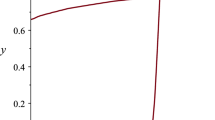Abstract
The number of simple zeroes common to a set of nonlinear equations is calculated exactly and analytically in terms of an integral taken over the boundary of the domain of interest. The integrand consists only of simple algebraic quantities containing the functions involved as well as their derivatives up to second order. The numerical feasibility is shown by some computed examples.
Zusammenfassung
Die genaue Anzahl der einfachen Nullstellen eines Systems nichtlinearer Gleichungen wird analytisch durch ein Integral über die Berandung des interessierenden Bereichs dargestellt. Der Integrand besteht aus einfachen algebraischen Größen, die die Funktionen samt ihren Ableitungen bis zur zweiten Ordnung enthalten. Die numerische Anwendbarkeit wird mit durchgerechneten Beispielen belegt.
Similar content being viewed by others
References
Kronecker, L.: Über Systeme von Funktionen mehrerer Variabeln. Monatsberichte der Königlich Preussischen Akademie der Wissenschaften zu Berlin, pp. 159–193 and pp. 688–698. Reprinted in: L. Kronecker, Werke, Vol. 1, pp. 175–212 and pp. 213–226. Leipzig: Teubner 1895. Kronecker, L.: Über die Charakteristik von Funktionen-Systemen. Monatsberichte der Königlich Preussischen Akademie der Wissenschaften zu Berlin, pp. 145–152, 1878. Reprinted in: L. Kronecker, Werke, Vol. 2, pp. 71–82. Leipzig: Teubner 1897.
Schwartz, L.: Cours d'analyse, Vol. 2, pp. 230–269. Paris: Hermann 1967.
Ortega, J. M., Rheinboldt, W. C.: Iterative solutions of nonlinear equations in several variables, chap. 6.3. London: Academic Press 1970.
Hutson, V., Pym, J. S.: Applications of functional analysis and operator theory, chap. 14. London: Academic Press 1980.
Sattinger, D. H.: Topics in stability and bifurcation theory (Lecture Notes in Mathematics, Vol. 309). Berlin-Heidelberg-New York: Springer 1973.
Picard, E.: Sur le nombre des racines communes à plusieurs équations simultanées. Journ. de Math. Pure et Appl. (4e série)8, 5–24 (1892).
Picard, E.: Traité d'analyse, 3rd ed., Vol. 1, chap. 4.7. Paris: Gauthier-Villars 1922.
Kaplan, W.: Advanced calculus, chap. 5.14, esp. problem 5. Reading, Mass.: Addison-Wesley 1963.
Davidoglou, A.: Sur le nombre de racines communes à plusieurs équations. Compt. Rend. hebd.133, 784–786, 860–863 (1901).
Tzitzéica, G.: Sur le nombre des racines communes à plusieurs équations. Compt. Rend. hebd.133, 918–920 (1901).
Branin, F. H., jr.: Widely convergent method for finding multiple solutions of simultaneous nonlinear equations. IBM J. Res. Develop.16, 504–522 (1972).
Rosenbrock, H. H.: An automatic method for finding the greatest or least value of a function. Comp. J.3, 175–184 (1960).
Author information
Authors and Affiliations
Rights and permissions
About this article
Cite this article
Hoenders, B.J., Slump, C.H. On the calculation of the exact number of zeroes of a set of equations. Computing 30, 137–147 (1983). https://doi.org/10.1007/BF02280784
Received:
Issue Date:
DOI: https://doi.org/10.1007/BF02280784




